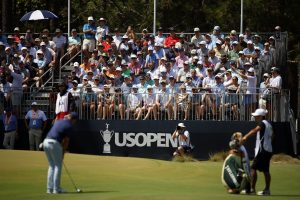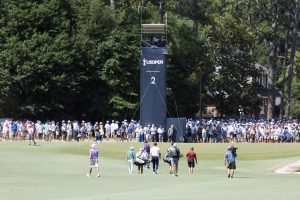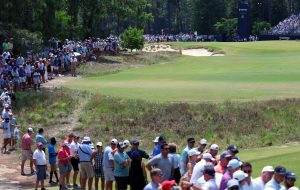Four Tricky Pinehurst Holes That Could Determine This Year’s U.S. Open Champion

By Chandler Hawkes, Sports@CJC
PINEHURST, N.C. — With the 124th U.S. Open championship hanging in the balance, Bryson DeChambeau sits atop the leaderboard at 7-under par. Given that three players are within three shots of the lead, Sunday’s final round at Pinehurst No. 2 is shaping up to be a dogfight, but for DeChambeau, it will be more of the same.
“Just going to say it, tomorrow it’s the same quote I’ve said all week: Trying to have boring golf,” DeChambeau said. “The middle of the greens never move, so I am going to try and hit a lot of the greens, give myself some good looks on some holes and two-putt a lot.”
After Thursday’s rounds, in which 15 players finished under par and two shot 5-under-par rounds of 65, Pinehurst No. 2 has fought back, browning up and getting really firm and fast, leaving just eight golfers under par for the tournament.
“Just a really difficult U.S. Open Saturday. I think everything we expected it to be,” said Rory McIlroy, who sits three strokes behind DeChambeau after Saturday’s 1-under 69. “The course is getting crispy. Some of the pin positions are pretty tricky.”
Every single hole on this Donald Ross-designed masterpiece warrants a player’s attention and patience, but certain holes can be the difference in winning or losing the U.S. Open. Each green presents its own unique challenges and the native areas are a coin flip whether you will draw a good lie or bad lie.
Every year, certain holes play a significant role in dictating the U.S. Open champion. And this year, these four — the par-4 second, the par-5 fifth, the par-3 sixth, and the par-4 16th — could be the difference.

Hole #2
“Tough, very tough, but fair,” Collin Morikawa said. “With some of the down grain areas, 2 — I don’t know what the hell to do on 2.”
The second hole is a 504-yard par 4 with a green that requires one of the most precise approach shots on the entire property.
In 2014, the last time the U.S. Open was at Pinehurst, it played as the third toughest hole on the weekend, conceding just 21 birdies, while producing 139 bogeys and 16 double-bogeys or worse. So far this year, through three rounds, it has conceded 11 birdies while producing 127 bogeys and 20 double bogeys or worse.
Take the par here and run to the next tee box.
Hole #5
This hole is critical not because of its difficulty — and, to be clear, by no stretch is it easy — but rather because it has played as the course’s easiest hole both this year and in 2014. There are not many scoring chances on this golf course, and this is the biggest chance you will get of putting a circle around a number on the scorecard.
The 588-yard par 5 is pretty straightforward: put your drive in the fairway and don’t miss left with your second shot, and you have an excellent chance to walk out of there with a birdie.
In 2014, there were 17 eagles and 144 birdies at No. 5, compared to only 56 bogeys and 14 double bogeys or worse. This year, through three rounds, there have been 13 eagles and 139 birdies, with only 34 bogeys and 12 doubles or worse.
The 2014 Open winner, Martin Kaymer, played the hole 4-under-par for the week, including an eagle in his third round to equal out bogeys on holes two and six.]

Xander Schauffele is a prime example of how crucial this hole can be to your tournament. He has played the fifth hole 3-over-par this week through three rounds and currently sits in T12 at 1-over for the tournament. Turn that bogey and double-bogey into birdies, and he is T2 and within striking distance of back-to-back major championship wins.
“I’m sure there will be a highlight of someone holing out or hitting a very close shot out there,” Schauffele said. “It’s very doable. We just made a mess of it.”
It shows that even the “easier” holes always require precision and patience.
Hole #6
The beastly 228-yard par-3 has consistently presented one of the biggest challenges for the best players in the world. In 2014, it was the hardest hole for the week, conceding just 12 birdies while producing 164 bogeys or worse. So far this year, it is the third-hardest hole, conceding 12 birdies and producing 146 bogeys or worse.
The sheer length of the hole combined with the green sloped severely back-to-front provides a brutal challenge, especially when the pin locations are near the front of the green. The top four players on the leaderboard have all played the hole at even par or better for the week except McIlroy, who has played it 1-over through three rounds.

Hole #16
The longest par 4 on the course at 530 yards is wedged between two 200-yard par-3’s in the closing stretch of holes, which will challenge the leader to string together four great tee shots, two great approach shots along with steady putting in order to lift the trophy on the 18th green as the sun sets on the 124th U.S. Open.
You can’t afford to miss this fairway, because the second shot will be nearly impossible to put on the green. Bunkers surround this green long, left and right, and in true Pinehurst No. 2 fashion, the ball will run off the green if played too close to the edges, including a severe slope at the front of the green.
In 2014, the 16th conceded 37 birdies but produced 165 bogeys or worse. This year, it conceded just 18 birdies and produced 118 bogeys or worse.
In today’s third round, DeChambeau brought the rest of the field back into the tournament a little bit with a double bogey. No lead is safe with this last stretch of holes.
Tom Kim did a good job of breaking down the feeling of playing the 16th hole along with No. 4, which is another 500-yard par-5.
“For example, 4, 16 are playing monstrous into the wind. Five something. Basically par 5s,” Kim said. “When you make par on those, it feels like you made two birdies. Guys have made mistakes on those holes, feels like you gain a ton of shots.”
It will take a valiant effort from the group at 4-under to catch DeChambeau, given his recent exceptional play, but they are going to give it their all for a chance to take home the trophy.
McIlroy is chasing his fifth major championship and understands that any lead can be wiped out with one errant mistake.
“No matter what happens, I feel like two shots, three shots, four shots, I’ve got a great chance going into tomorrow,” McIlroy said.
Category: Covering the U.S. Open
Tagged: 2024 U.S. Open Covering the U.S. Open
Subscribe to our News Digest


